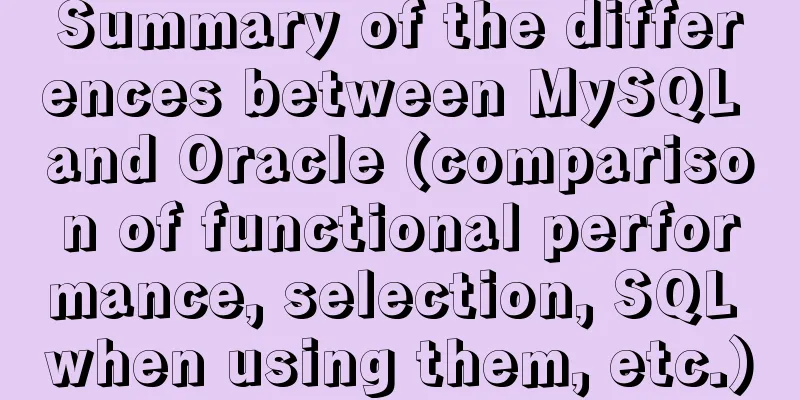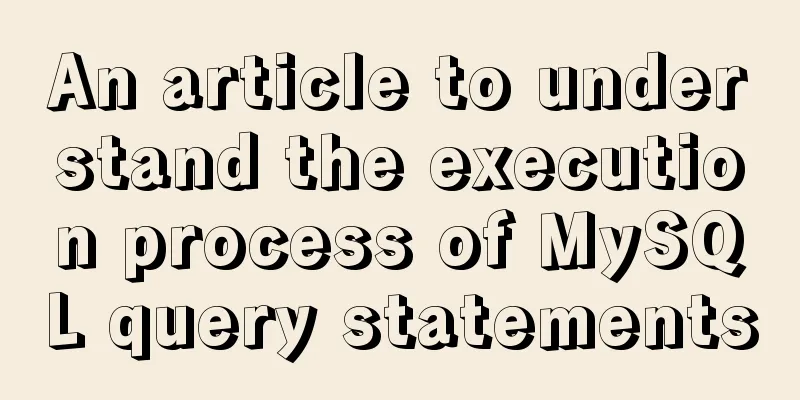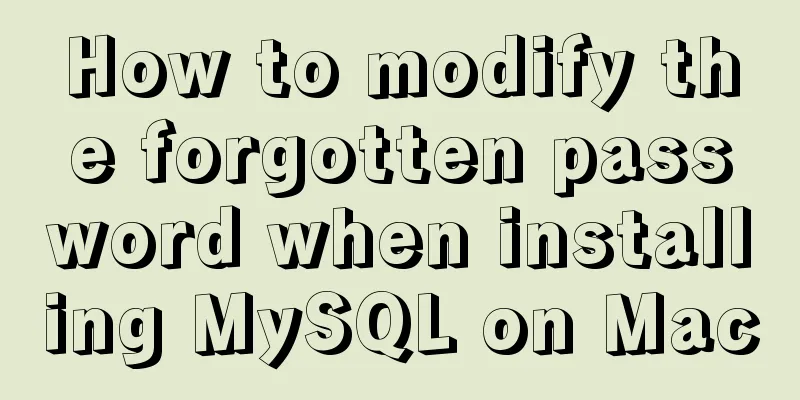Summary of the differences between MySQL and Oracle (comparison of functional performance, selection, SQL when using them, etc.)

|
1. Concurrency Concurrency is the most important feature of OLTP database, but concurrency involves the acquisition, sharing and locking of resources. mysql: oracle: 2. Consistency oracle: mysql: 3. Affairs Oracle has fully supported transactions for a long time. MySQL supports transactions only with row-level locks in the InnoDB storage engine. 4. Data persistence oracle 5. Submission Method Oracle does not automatically submit by default and requires the user to submit manually. 6. Logical backup Oracle does not lock data during logical backup, and the backed up data is consistent. When performing a logical backup of MySQL, the data must be locked to ensure that the backed-up data is consistent, which affects the normal use of DML in the business. 7. Hot backup Oracle has a mature hot standby tool, RMAN, which does not affect users' use of the database during hot standby. Even if the backed up database is inconsistent, it can be restored consistently through archive logs and online redo logs. 8. Extension and flexibility of SQL statements MySQL has many very practical and convenient extensions to SQL statements, such as the limit function, the insert function that can insert multiple rows of data at a time, and the select function that can select certain management data without adding from. IX. Copy Oracle: It has both push or pull traditional data replication and DataGuard's dual-machine or multi-machine disaster recovery mechanism. If there is a problem with the main database, the backup database can be automatically switched to the main database, but the configuration management is more complicated. 10. Performance Diagnosis Oracle has a variety of mature performance diagnosis and tuning tools that can implement many automatic analysis and diagnosis functions. Such as awr, addm, sqltrace, tkproof, etc. 11. Permissions and Security The mysql user is related to the host, which seems meaningless. In addition, it is easier for the host and IP to be counterfeited. 12. Partition tables and partition indexes 13. Management Tools 14. Technical Support If there is a problem with Oracle, you can contact customer service Solve mysq problems yourself 15. Authorization Oracle charges mysq open source - free 16. Choice If you have money, I suggest you use Oracle. If you don’t have money but can meet your needs, I recommend using mysq. (Alibaba, Wikipedia and other large projects also use MySQL, and they mainly use distributed storage, caching, table and database sharding and other technologies) Here is another article, mainly comparing from the sql aspect: The difference between Oracle database and MySQL database is the main content of this article. I hope it can be helpful to you. 1. Group function usage rules In MySQL, group functions can be used freely in select statements, but in Oracle, if there is a group function in the query statement, the other column names must be processed by the group function or be columns in the group by clause, otherwise an error will be reported. For example: select name, count(money) from user; This works fine in MySQL but has problems in Oracle. 2. Automatic growth data type processing MYSQL has an automatically growing data type. When inserting records, you do not need to operate this field, and the data value will be automatically obtained. ORACLE does not have an automatically increasing data type, so you need to create an automatically increasing sequence number and assign the next value of the sequence number to this field when inserting a record. CREATE SEQUENCE sequence number name (preferably table name + sequence number tag) INCREMENT BY 1 START WITH 1 MAXVALUE 99999 CYCLE NOCACHE; The maximum value is determined by the length of the field. If the automatically increasing sequence number NUMBER(6) is defined, the maximum value is 999999 The INSERT statement inserts this field value: the name of the serial number.NEXTVAL 3. Processing of single quotes In MYSQL, you can use double quotes to enclose strings, but in ORACLE, you can only use single quotes to enclose strings. Before inserting and modifying a string, single quotes must be replaced: all occurrences of a single quote are replaced with two single quotes. 4. Processing of SQL statements for page turning The SQL statement for MYSQL to process page turning is relatively simple. Use LIMIT to set the starting position and record the number. In PHP, you can also use SEEK to locate the position of the result set. The SQL statements for ORACLE to process page turning are rather complicated. Each result set has only one ROWNUM field to indicate its position, and only ROWNUM<100 can be used, not ROWNUM>80. The following are two better ORACLE page turning SQL statements after analysis (ID is the field name of the unique keyword): Statement 1: SELECT ID, [FIELD_NAME,...] FROM TABLE_NAME WHERE ID IN ( SELECT ID FROM (SELECT ROWNUM AS NUMROW, ID FROM TABLE_NAME WHERE condition1 ORDER BY condition2) WHERE NUMROW > 80 AND NUMROW < 100 ) ORDER BY condition3; Statement 2: SELECT * FROM (( SELECT ROWNUM AS NUMROW, c.* from (select [FIELD_NAME,...] FROM TABLE_NAME WHERE condition1 ORDER BY condition2) c) WHERE NUMROW > 80 AND NUMROW < 100 ) ORDER BY condition3; 5. Processing of long strings ORACLE also has its own special features in processing long strings. The maximum operable string length for INSERT and UPDATE is less than or equal to 4000 single bytes. If you want to insert a longer string, consider using the CLOB type for the field, using the DBMS_LOB package that comes with ORACLE. Before inserting or modifying records, you must perform non-empty and length checks. Field values that cannot be empty and field values that exceed the length should issue a warning and return to the last operation. 6. Processing of date fields MYSQL date fields are divided into DATE and TIME. ORACLE date fields only have DATE, which contains year, month, day, hour, minute, and second information. The system time of the current database is SYSDATE, accurate to seconds, or the string is converted into a date type function TO_DATE('2001-08-01','YYYY-MM-DD') Year-month-day 24 hours: minutes: seconds format YYYY-MM-DD HH24:MI:SS TO_DATE() There are many other date formats, you can refer to ORACLE DOC. Date field conversion string function TO_CHAR('2001-08-01','YYYY-MM-DD HH24:MI:SS') Mathematical formulas for date fields are very different. MYSQL finds the date 7 days from the current time using DATE_FIELD_NAME > SUBDATE(NOW(), INTERVAL 7 DAY) ORACLE finds the date 7 days from the current time using DATE_FIELD_NAME > SYSDATE - 7; Several functions in MYSQL that insert the current time are: The NOW() function returns the current date and time as `'YYYY-MM-DD HH:MM:SS', which can be directly stored in the DATETIME field. CURDATE() returns today's date in the format of 'YYYY-MM-DD' and can be stored directly in a DATE field. CURTIME() returns the current time in the format of 'HH:MM:SS' and can be stored directly in the TIME field. Example: insert into tablename (fieldname) values (now()) The current time in Oracle is sysdate 7. Handling of Null Characters MYSQL's non-empty fields also have empty contents, but ORACLE does not allow empty contents in non-empty fields. Defining the ORACLE table structure according to MYSQL's NOT NULL will result in errors when importing data. Therefore, when importing data, you need to judge the empty character. If it is NULL or an empty character, you need to change it to a string of spaces. 8. Fuzzy comparison of strings In MYSQL, use field name like%' string %'. In ORACLE, you can also use field name like%' string %', but this method cannot use indexes and is not fast. Using the string comparison function instr(field name, ' string ')>0 will get more accurate search results. 9. In programs and functions , please pay attention to releasing result sets and pointers after completing database operations. You may also be interested in:
|
<<: Installation steps of Ubuntu 20.04 double pinyin input method
>>: Ubuntu 20.04 how to modify the IP address example
Recommend
CSS3 uses var() and calc() functions to achieve animation effects
Preview knowledge points. Animation Frames Backgr...
WeChat Mini Programs are shared globally via uni-app
In actual use, it is often necessary to share the...
Detailed explanation of the use of various MySQL indexes
1. Slow query log 1.1 MySQL log types Logs are us...
Teach you how to enable the Linux subsystem of Win10 (with detailed pictures and text)
Today I will introduce how to enable the Linux su...
Docker+selenium method to realize automatic health reporting
This article takes the health reporting system of...
CentOS7.5 installation tutorial of MySQL
1. First check whether the system has mysql insta...
Nginx learning how to build a file hotlink protection service example
Preface Everyone knows that many sites now charge...
WeChat applet scroll-view realizes left-right linkage effect
WeChat applet uses scroll-view to achieve left-ri...
Detailed explanation of compiling and installing MySQL 5.6 on CentOS and installing multiple MySQL instances
--1. Create a new group and user for mysql # user...
30 minutes to give you a comprehensive understanding of React Hooks
Table of contents Overview 1. useState 1.1 Three ...
Two ways to open and close the mysql service
Method 1: Use cmd command First, open our DOS win...
Click the button to turn the text into an input box, click Save to turn it into text implementation code
Click the button to turn the text into an input b...
Several ways to encapsulate axios in Vue
Table of contents Basic Edition Step 1: Configure...
How to create a Django project + connect to MySQL
1: django-admin.py startproject project name 2: c...
How to install MySQL via SSH on a CentOS VPS
Type yum install mysql-server Press Y to continue...









